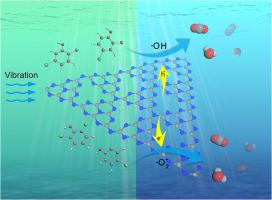Journal of Hazardous Materials ( IF 12.2 ) Pub Date : 2021-07-22 , DOI: 10.1016/j.jhazmat.2021.126696 Hua Lei 1 , Qingshen He 1 , Meixuan Wu 1 , Yingying Xu 1 , Pengfei Sun 1 , Xiaoping Dong 1

|
Graphitic carbon nitride (g-C3N4) has been proved to be a potential photocatalyst for environment purification, but the high recombination rate of photogenerated carriers leads to the low photocatalytic efficiency. Herein, we report the enhanced degradation of chlorophenols by 2D ultrathin g-C3N4 nanosheets with intrinsic piezoelectricity through photopiezocatalysis strategy. Under the simultaneous visible-light irradiation and ultrasonic vibration, the 2D g-C3N4 presented improved removal efficiency for elimination of 2,4-dichlorophenol (2,4-DCP) with an apparent rate constant of 6.65 × 10−2 min−1, which was 6.7 and 2.2 times of the photocatalysis and piezocatalysis, respectively. The improved removal efficiency was attributed to the sufficient separation of free charges driven by the ultrasound-induced piezoelectric field in the 2D g-C3N4, which was demonstrated by the enhanced current response under photopiezocatalysis mode. Additionally, the photopiezocatalysis of 2D g-C3N4 was proved to possess well universality for removing different chlorophenols, as well as high durability and dechlorination efficiency. Finally, a possible photopiezocatalytic mechanism for removal of 2,4-DCP was proposed based on the electron paramagnetic resonance (EPR) technique and the determination of intermediates through liquid chromatography-mass spectrometry (LC-MS) analysis. This work provides a promising strategy for the design of energy-conversion materials towards capturing solar and mechanical energy in ambient environment.
中文翻译:

压电极化促进二维 g-C3N4 纳米片中光激发电子和空穴的空间分离,以有效消除氯酚
石墨氮化碳(gC 3 N 4)已被证明是一种潜在的环境净化光催化剂,但光生载流子的高复合率导致光催化效率低。在此,我们通过光电催化策略报告了具有固有压电性的二维超薄 gC 3 N 4纳米片对氯酚的降解增强。在同时可见光照射和超声振动下,2D gC 3 N 4表现出提高的去除效率以消除 2,4-二氯苯酚 (2,4-DCP),表观速率常数为 6.65 × 10 -2 min -1,分别是光催化和压电催化的 6.7 倍和 2.2 倍。去除效率的提高归因于在 2D gC 3 N 4 中由超声诱导的压电场驱动的自由电荷的充分分离,这通过光压电催化模式下增强的电流响应来证明。此外,2D gC 3 N 4的光压电催化被证明具有很好的去除不同氯酚类物质的通用性,以及较高的耐久性和脱氯效率。最后,基于电子顺磁共振 (EPR) 技术和液相色谱-质谱 (LC-MS) 分析确定中间体,提出了一种可能的光压电催化去除 2,4-DCP 的机制。这项工作为设计能量转换材料以捕获周围环境中的太阳能和机械能提供了一种有前景的策略。











































 京公网安备 11010802027423号
京公网安备 11010802027423号